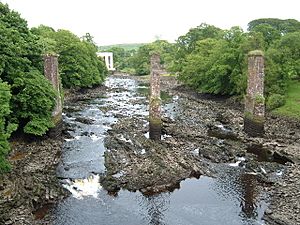River Dee, Galloway facts for kids
Quick facts for kids River Dee |
|
|---|---|

View of the Dee at Tongland
|
|
| Country | Scotland |
| Region | Galloway |
| Settlements | Kirkcudbright, Tongland, Bridge of Dee, Glenlochar, Crossmichael, Parton |
| Physical characteristics | |
| Main source | Loch Dee |
| River mouth | Kirkcudbright Bay |
| Length | 61 km (38 mi) |
| Basin features | |
| Basin size | 1,050 km2 (410 sq mi) |
| Tributaries |
|
| Protection status | |
| Official name: Loch Ken & River Dee Marshes | |
| Designated: | 31 August 1992 |
| Reference #: | 568 |
The River Dee is a river in south-west Scotland. It starts in Loch Dee in the Galloway Hills. From there, it flows into Clatteringshaws Loch and then into Loch Ken. In Loch Ken, it meets another river called the Water of Ken.
After Loch Ken, the River Dee flows about 15 miles (24 km) south. It passes through Kirkcudbright and then enters Kirkcudbright Bay. Finally, it reaches the Solway Firth, which is part of the sea. The whole river is just over 38 miles (61 km) long. The area of land that drains into the River Dee and its smaller rivers is over 400 square miles (1,050 km²).
Contents
Power and History of the River Dee
The River Dee has a dam at Tongland, about 2 miles (3 km) from Kirkcudbright. This dam was built in the 1930s. It is part of the Galloway hydro-electric power scheme. This scheme uses the power of the river's water to make electricity.
Near the dam, you can see Tongland Bridge. This old bridge was built in 1806 by a famous engineer named Thomas Telford.
Threave Castle and Ancient Names
On an island in the lower part of the River Dee, you can find the ruins of Threave Castle. This old castle is a cool historical site to explore.
Long ago, in the 2nd century, a Greek writer named Ptolemy wrote about the River Dee. In his book Geography, he called it Dēoúa. This name likely came from an old word meaning 'a goddess'. Many rivers in Celtic areas have names related to goddesses.
The River Dee is also sometimes called the Black Water of Dee. This is because the water in the part above Loch Ken can look quite dark.
Protecting the River Dee
Loch Ken and the areas around the Dee River are very important for nature. Because of this, they were named a Ramsar site on August 21, 1992. A Ramsar site is a special wetland area that is important for birds and other wildlife around the world. It helps protect these natural habitats.
Tarff Water: A Tributary
The Tarff Water is a smaller river that flows into the River Dee. It joins the Dee near Tongland. The streams that form the Tarff Water start in the area between the villages of Laurieston and Ringford. This includes Loch Mannoch.
The name Tarff comes from an old word meaning 'bull'. Bulls often appear in the names of Celtic rivers. These names might have been linked to old myths or stories, rather than just meaning there were bulls there.

